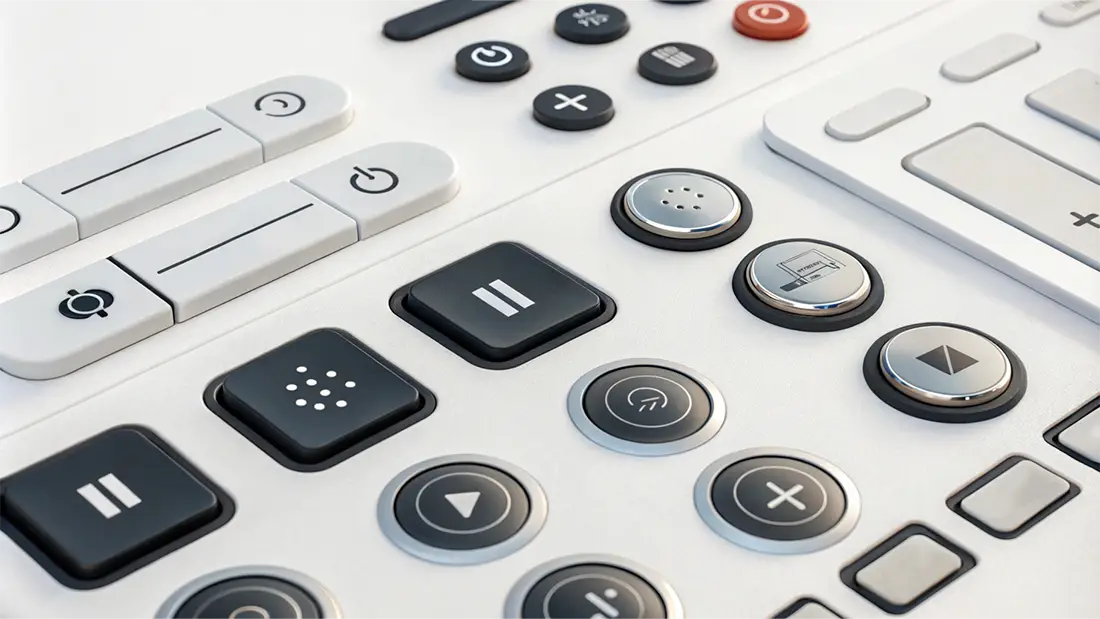It's no secret that in the fast-paced world of SaaS, your user interface can make or break your product. It's more than just a pretty face – it's the key to attracting and keeping users engaged. A solid design system is the foundation for a successful user experience. But let's face it: even the best-designed systems can become a headache as your SaaS scales. How do you maintain consistency across all your platforms and modules? How do you prevent your design system from becoming a burden for your team? The answer lies in a powerful, but often overlooked tool: design tokens. These small but mighty variables are the secret to a robust, scalable design system that can keep pace with your SaaS growth.
Table of contents
What Exactly is a Design Token? Let's Break it Down.
Okay, we get it: having a solid design system is essential. But how do you ensure everything stays consistent and manageable as your SaaS grows at lightning speed? The answer lies in a tool that's as subtle as it is powerful: Design Tokens!
Picture this: every color, font, spacing—everything that makes up your interface—neatly organized in a virtual toolbox, each with a clear and precise label. That's the idea behind tokens! Each design element gets its own little code name, its unique reference.
What does that look like in practice?
- That deep blue in your logo? It becomes a design token called "blue-logo," accessible and consistent everywhere.
- The elegant typography used for your headings? That's a token called "heading-font-primary," with all its characteristics (size, weight, spacing, etc.) saved and ready to use.
- That perfect spacing between your buttons that gives your interface room to breathe? Now it's the "button-spacing-standard" token, no more headaches trying to remember the exact value.
Sounds pretty straightforward, right? And the truth is, it really is! Design tokens are like a magic bullet for design consistency and smooth collaboration.
The Benefits of Design Tokens for Your SaaS (and Your Peace of Mind!)
So we've covered what a design token is, but what are the real-world benefits for your SaaS? Here's why design tokens are much more than just a design trend.
1. Enhanced Consistency, Stronger Brand Identity
No more leaving visual details to chance! With design tokens, colors, fonts, and spacing are precisely defined and reused consistently across your entire interface. The result? A cohesive design that strengthens your brand identity and builds trust with your users. You can even customize the tokens to your clients' branding !
2. Faster Development, Easier Maintenance
Design tokens streamline collaboration between designers and developers. No more digging through endless lines of code to find the right color or font: a token is clear, concise, and accurate. Updates are also simplified: a single change to a token automatically ripples through every instance where it's used.
3. Built-in Flexibility and Adaptability
Need to evolve your SaaS? New features, a fresh brand identity, adapting to dark mode...no problem! Design tokens make your design system incredibly easy to update. A single change to a token's value, and your entire interface adapts in a snap.
4. Improved Designer-Developer Collaboration
Design tokens act like a shared language that smooths communication between teams. Say goodbye to misunderstandings and endless back-and-forths: everyone works from the same set of references, ensuring a cohesive and polished final product.
To sum it up, design tokens are a game-changer for:
- Boosting efficiency and productivity.
- Strengthening your brand identity.
- Delivering an optimal user experience.
Classic Tokens vs. Semantic Tokens
We've established that tokens are a powerful tool for building a robust design system. But there are actually different types of tokens, each with its own characteristics. Don't worry, we'll break it all down!
1. Classic Design Tokens: The Raw Values
These are the basic tokens we've discussed so far. They define a specific property, such as:
- color-primary: #007BFF (a nice, vibrant blue)
- spacing-small: 8px
- font-paragraph: Roboto Regular, 16px
Clear, precise, efficient. Perfect for getting started... but potentially limiting as your design system grows! You might end up with hundreds of tokens with generic names, making them difficult to manage and organize.
2. Semantic Design Tokens: Design with Meaning
Instead of just defining a value, semantic tokens express an intent, a role. So we'll choose more descriptive names, like:
- color-background-primary
- spacing-elements-close
- font-text-secondary
The result? A system that's clearer, more readable, and easier to maintain. But that's not all! Semantic tokens also offer greater flexibility.
Why Use Semantic Tokens?
Imagine your SaaS uses the color #007BFF (that vibrant blue) for the background of your primary buttons.
- With classic tokens: you'd create a token called button-primary-background: #007BFF. If you decide to change the color of all your buttons, you'd have to modify each token individually.
- With semantic tokens: you'd create a token called color-interactive-primary: #007BFF. This token could be used for the background of buttons, but also for other important interactive elements. If you want to change the color, a single modification in your Color System is all it takes!
This is the power of semantic tokens: they adapt to the evolution of your product. Rather than describing a specific element, they describe its role and function.
A Trap to Avoid: Overly Specific Tokens
It might be tempting to create hyper-specific tokens tied to a single component, for example: button-login-background-color. The problem? You lose flexibility and end up with a ton of tokens that are difficult to manage.
Tokens: Laying the Foundation (Primitive Tokens)
Before we dive into the "classic vs. semantic" match, it's essential to understand that every token system relies on fundamental elements: primitive tokens. These are the building blocks of your design system—the raw, immutable values that define your core colors, fonts, and spacing.
For example:
color-blue-primary: #007BFFfont-primary: Robotospacing-base: 8px
These primitive tokens aren't usually used directly in your interface code. They serve as the basis for constructing the other types of tokens (classic and semantic) and ensure absolute consistency throughout your entire design system.
How to Create a Killer Token System
Okay, we're all convinced: tokens are the secret to a strong and scalable design system. But how do you actually put all this into practice? No worries, we'll guide you step by step!
1. The Audit: Comb Through Your Design
Before diving headfirst into creating your tokens, take the time to analyze your existing design system. What colors, fonts, and spacing are you already using? Are they consistent with each other? The goal is to identify the key elements of your visual identity and spot any inconsistencies.
To help you with this process, check out our dedicated article on UX audits for SaaS.
2. Choose Your Weapons: The Right Tools for the Job
The good news is there are plenty of great tools to make your life easier! Figma, Adobe XD, Zeroheight... each has its own unique features, so take the time to compare and choose the one that best suits your needs and workflow. At merveilleUX, we use Figma.
3. Create Your Token Library: Organization is Key
Now it's time to get down to business! Define each token carefully, choosing names that are clear, descriptive, and above all, scalable (avoid obscure abbreviations and overly long names). Good organization is essential: create categories and subcategories to make it easy to navigate. Designers and developers should collaborate to define names that make sense for both teams.
4. Test, Adjust, Improve: Your Design System is a Living Thing!
A design system isn't set in stone—it lives and evolves with your product. Be prepared to make adjustments as your SaaS grows and your needs change. The important thing is to stay flexible and not be afraid to rethink your initial choices.
Creating an effective token system requires some investment, but it's a major asset for the future of your SaaS. A robust and scalable design system with well-defined tokens guarantees a consistent user interface that's easy to maintain and ready to face any challenge!
Conclusion
In conclusion, design tokens are becoming essential allies for SaaS companies looking to build a solid, scalable design system that can support their growth. A Design System is more than just a trend, and design tokens, especially semantic tokens, offer a structured and efficient approach to ensure flawless visual consistency, easier maintenance, and smoother collaboration between teams.
Sure, implementing a token system requires some upfront investment. But the long-term benefits, both in terms of efficiency and brand image, are well worth the effort. Outsourcing UX design can be a smart option to help guide you through this process. So, ready to take your design system to the next level with design tokens?




